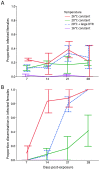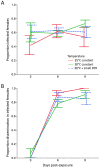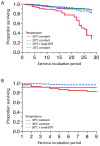Fluctuations at a low mean temperature accelerate dengue virus transmission by Aedes aegypti
- PMID: 23638208
- PMCID: PMC3636080
- DOI: 10.1371/journal.pntd.0002190
Fluctuations at a low mean temperature accelerate dengue virus transmission by Aedes aegypti
Abstract
Background: Environmental factors such as temperature can alter mosquito vector competence for arboviruses. Results from recent studies indicate that daily fluctuations around an intermediate mean temperature (26°C) reduce vector competence of Aedes aeygpti for dengue viruses (DENV). Theoretical predictions suggest that the mean temperature in combination with the magnitude of the diurnal temperature range (DTR) mediate the direction of these effects.
Methodology/principal findings: We tested the effect of temperature fluctuations on Ae. aegypti vector competence for DENV serotype-1 at high and low mean temperatures, and confirmed this theoretical prediction. A small DTR had no effect on vector competence around a high (30°C) mean, but a large DTR at low temperature (20°C) increased the proportion of infected mosquitoes with a disseminated infection by 60% at 21 and 28 days post-exposure compared to a constant 20°C. This effect resulted from a marked shortening of DENV extrinsic incubation period (EIP) in its mosquito vector; i.e., a decrease from 29.6 to 18.9 days under the fluctuating vs. constant temperature treatment.
Conclusions: Our results indicate that Ae. aegypti exposed to large fluctuations at low temperatures have a significantly shorter virus EIP than under constant temperature conditions at the same mean, leading to a considerably greater potential for DENV transmission. These results emphasize the value of accounting for daily temperature variation in an effort to more accurately understand and predict the risk of mosquito-borne pathogen transmission, provide a mechanism for sustained DENV transmission in endemic areas during cooler times of the year, and indicate that DENV transmission could be more efficient in temperate regions than previously anticipated.
Conflict of interest statement
The authors have declared that no competing interests exist.
Figures



Similar articles
-
Impact of daily temperature fluctuations on dengue virus transmission by Aedes aegypti.Proc Natl Acad Sci U S A. 2011 May 3;108(18):7460-5. doi: 10.1073/pnas.1101377108. Epub 2011 Apr 18. Proc Natl Acad Sci U S A. 2011. PMID: 21502510 Free PMC article.
-
Reduction of Aedes aegypti vector competence for dengue virus under large temperature fluctuations.Am J Trop Med Hyg. 2013 Apr;88(4):689-97. doi: 10.4269/ajtmh.12-0488. Epub 2013 Feb 25. Am J Trop Med Hyg. 2013. PMID: 23438766 Free PMC article.
-
The impact of temperature and Wolbachia infection on vector competence of potential dengue vectors Aedes aegypti and Aedes albopictus in the transmission of dengue virus serotype 1 in southern Taiwan.Parasit Vectors. 2017 Nov 7;10(1):551. doi: 10.1186/s13071-017-2493-x. Parasit Vectors. 2017. PMID: 29116011 Free PMC article.
-
Vector competence of Aedes aegypti and Aedes albopictus (Diptera: Culicidae) for dengue virus in the Florida Keys.J Med Entomol. 2012 Jul;49(4):942-6. doi: 10.1603/me11293. J Med Entomol. 2012. PMID: 22897056
-
Endogenous non-retroviral elements in genomes of Aedes mosquitoes and vector competence.Emerg Microbes Infect. 2019;8(1):542-555. doi: 10.1080/22221751.2019.1599302. Emerg Microbes Infect. 2019. PMID: 30938223 Free PMC article. Review.
Cited by
-
Multilevel analysis of social, climatic and entomological factors that influenced dengue occurrence in three municipalities in Colombia.One Health. 2021 Mar 5;12:100234. doi: 10.1016/j.onehlt.2021.100234. eCollection 2021 Jun. One Health. 2021. PMID: 33855157 Free PMC article.
-
Empirical Dynamic Modelling Identifies different Responses of Aedes Polynesiensis Subpopulations to Natural Environmental Variables.Sci Rep. 2018 Nov 13;8(1):16768. doi: 10.1038/s41598-018-34972-w. Sci Rep. 2018. PMID: 30425277 Free PMC article.
-
Increased temperatures reduce the vectorial capacity of Aedes mosquitoes for Zika virus.Emerg Microbes Infect. 2020 Jan 2;9(1):67-77. doi: 10.1080/22221751.2019.1707125. eCollection 2020. Emerg Microbes Infect. 2020. PMID: 31894724 Free PMC article.
-
Coinfection with Zika Virus (ZIKV) and Dengue Virus Results in Preferential ZIKV Transmission by Vector Bite to Vertebrate Host.J Infect Dis. 2018 Jul 13;218(4):563-571. doi: 10.1093/infdis/jiy196. J Infect Dis. 2018. PMID: 29659904 Free PMC article.
-
Impact of environmental factors on the spread of dengue fever in Sri Lanka.Int J Environ Sci Technol (Tehran). 2022;19(11):10637-10648. doi: 10.1007/s13762-021-03905-y. Epub 2022 Jan 14. Int J Environ Sci Technol (Tehran). 2022. PMID: 35043053 Free PMC article.
References
-
- Barbazan P, Guiserix M, Boonyuan W, Tuntaprasart W, Pontier D, Gonzalez J-P (2010) Modelling the effect of temperature on transmission of dengue. Med Vet Entomol 24: 66–73. - PubMed
-
- Halstead SB (2008) Dengue virus - Mosquito interactions. Ann Rev Entomol 53: 273–291. - PubMed
-
- McLean DM, Clarke AM, Coleman JC, Montalbetti CA, Skidmore AG, et al. (1974) Vector capability of Aedes aegypti mosquitoes for California encephalitis and dengue viruses at various temperatures. Can J Microbiol 20: 255–262. - PubMed
-
- McLean DM, Miller MA, Grass PN (1975) Dengue virus transmission by mosquitoes incubated at low temperatures. Mosq News 35: 322–327.
-
- Rohani A, Wong YC, Zamre I, Lee HL, Zurainee MN (2009) The effect of extrinsic incubation temperature on development of dengue serotype 2 and 4 viruses in Aedes aegypti (L.). Southeast Asian J Trop Med Pub Health 40: 942–950. - PubMed
Publication types
MeSH terms
LinkOut - more resources
Full Text Sources
Other Literature Sources

